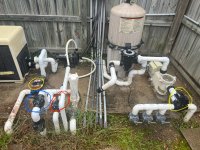Last November, at the beginning of "hot tub season," we went to go fire up our heater and the service light came on. Pool repair company found that the high limit switch had failed/went bad, so they replaced it. Heater was working great all season, no additional issues.
A couple months later, we started having issues with the spa slowly draining back into the pool when the pump was low or off. Pool repair company came to replace check valve. Didn't resolve issue. Came back and replaced internals on check valve protecting the heater from chlorine. Didn't resolve issue. They then gave us the runaround for 3 months and ghosted multiple appointments. We ended up leaving it alone because it did not drain much, and refilled quickly when the pump was on it's higher speed during the day w/ spa overspill.
A couple days ago, we went to fire up our heater for the first time in a while, and it struggled to fire up, then the service heater light came back on, and the keypad totally froze. The screen was still working (was showing current water temp and changed a degree here or there during the daytime vs. nighttime) but there was no way to turn off the unit because the buttons weren't working. It wasn't heating, and we turned off the gas also going to the unit. We then started having issues getting the pump to prime & not have air in it after using the automation (very old, 1996 AquaLink 2) to switch from spa to pool mode.
Today, a pool repair company came (different one from 2022) to check it out and they said they will need to replace the keypad/display, and that the high limit switch is bad again, and also needs to be replaced. They said that it's possible the internals on our actuator valves that switch from pool mode to spa mode could use some repair/replacement because of age, and they suspect that is what is causing the spa to drain back into the pool slowly. Without using the automation controller (on a wall inside our house), when they messed with the valves, they had no issue getting prime and there hasn't been any air in the system.
So a couple questions I'm curious about:
1. Is is common for the HLS to fail or need to be replaced annually? Is there something that maybe I'm doing/not doing that is causing that or making it worse? Would love to not have to replace it every year unless that's "normal."
2. Is it possible that the automation operating the actuator valves causes them issues when operating them "manually" (or using the buttons on the actuators themselves) doesn't?
3. Maybe a silly question...but does the pump need to be off or on when switching from pool to spa mode? Or does it not matter?
THANK YOU for all your knowledge and support!
A couple months later, we started having issues with the spa slowly draining back into the pool when the pump was low or off. Pool repair company came to replace check valve. Didn't resolve issue. Came back and replaced internals on check valve protecting the heater from chlorine. Didn't resolve issue. They then gave us the runaround for 3 months and ghosted multiple appointments. We ended up leaving it alone because it did not drain much, and refilled quickly when the pump was on it's higher speed during the day w/ spa overspill.
A couple days ago, we went to fire up our heater for the first time in a while, and it struggled to fire up, then the service heater light came back on, and the keypad totally froze. The screen was still working (was showing current water temp and changed a degree here or there during the daytime vs. nighttime) but there was no way to turn off the unit because the buttons weren't working. It wasn't heating, and we turned off the gas also going to the unit. We then started having issues getting the pump to prime & not have air in it after using the automation (very old, 1996 AquaLink 2) to switch from spa to pool mode.
Today, a pool repair company came (different one from 2022) to check it out and they said they will need to replace the keypad/display, and that the high limit switch is bad again, and also needs to be replaced. They said that it's possible the internals on our actuator valves that switch from pool mode to spa mode could use some repair/replacement because of age, and they suspect that is what is causing the spa to drain back into the pool slowly. Without using the automation controller (on a wall inside our house), when they messed with the valves, they had no issue getting prime and there hasn't been any air in the system.
So a couple questions I'm curious about:
1. Is is common for the HLS to fail or need to be replaced annually? Is there something that maybe I'm doing/not doing that is causing that or making it worse? Would love to not have to replace it every year unless that's "normal."
2. Is it possible that the automation operating the actuator valves causes them issues when operating them "manually" (or using the buttons on the actuators themselves) doesn't?
3. Maybe a silly question...but does the pump need to be off or on when switching from pool to spa mode? Or does it not matter?
THANK YOU for all your knowledge and support!


